Images of War
[Author: Rachel Boak, Curator]
The wartime collection of Orkney Islands Council includes paintings, prints and photographs depicting significant moments, such as the aftermath of the Battle of Jutland in 1916 and the surrender of the German fleet in 1918, demonstrating how artists and service personnel have responded to the terror, spectacle, politics, comradeship and loss of war. The images also show the central role played by Scapa Flow and Orkney in two world wars and the Royal Navy’s ongoing association with the islands.
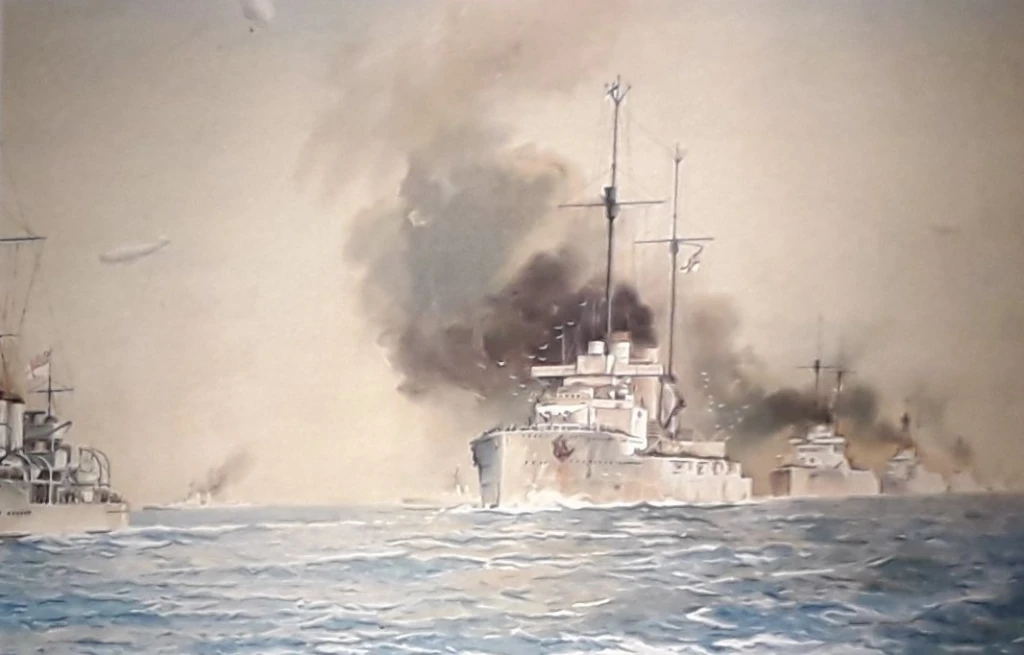
Some of the paintings or works by the same artists are on the Art UK website. Art UK is the online home for every public art collection in the UK. It is a charity and makes art available for everyone – for enjoyment, learning and research. See https://artuk.org/
Here is a selection of highlights from Orkney Islands Council’s collection.
Submarined Ship Coming into Kirkwall, 1917
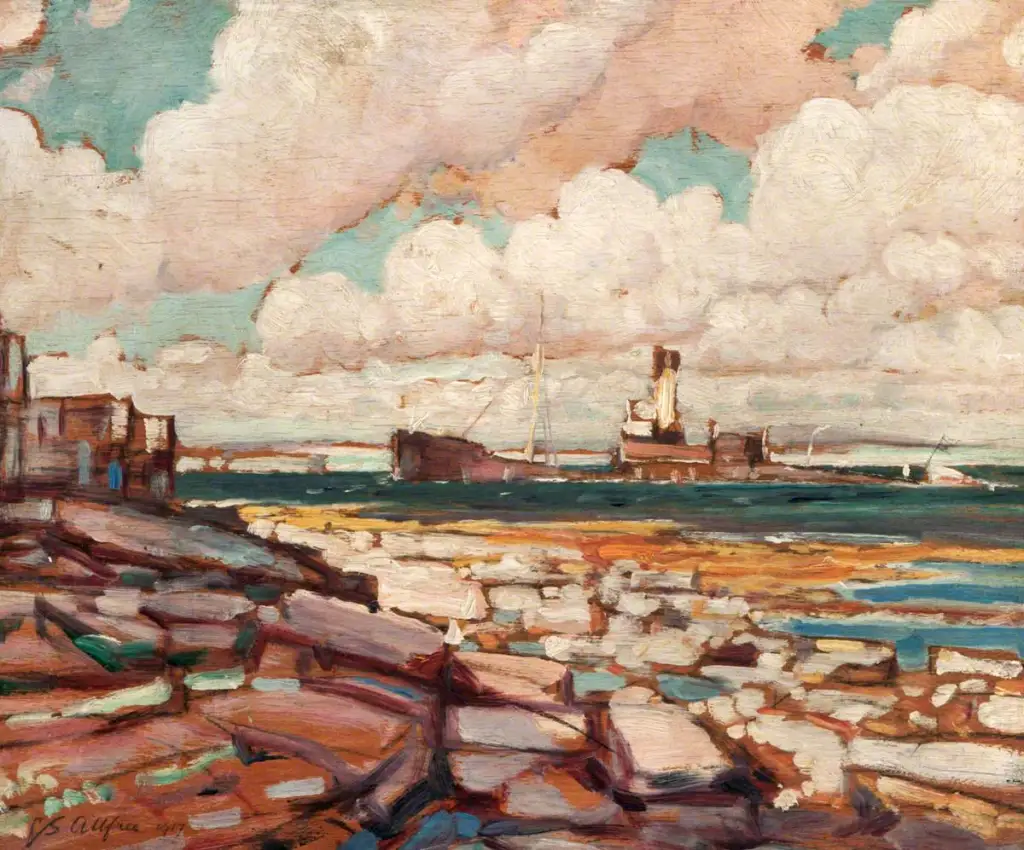
Lt. Cmd. Geoffrey S. Allfree R.B.A. (1889-1918), Submarined Ship Coming into Kirkwall, 1917, oil on board
This painting shows a ship damaged in a submarine attack limping into Kirkwall harbour, barely afloat. Lt. Cmd. Allfree R.N.V.R., R.B.A. was Official Artist to The Navy from 1914-1918 when he died of wounds off the north coast of Cornwall. Most of his other known work is in the Imperial War Museum in London.
For other works by this artist, visit ArtUk: Geoffrey Stephen Allfree
After the Battle - Returning to Port
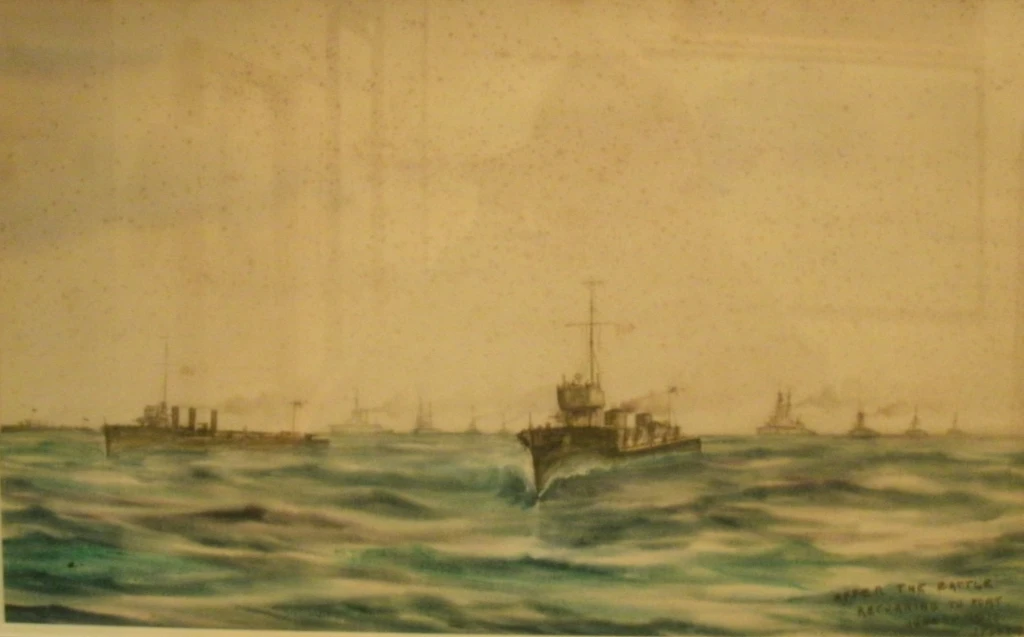
J. Fleck, After the Battle – returning to port, June 2nd 1916, watercolour on paper
Admiral Sir John Jellicoe received information in May 1916 that the German Fleet was gathering in large numbers for a raid into the North Sea. The Grand Fleet sailed from Scapa Flow on the night of 30 May led by Jellicoe in HMS Iron Duke. Ships stationed in the Firth of Forth under Admiral Beatty also sailed and met the German High Seas Fleet off the coast of Denmark on 31 May, beginning the Battle of Jutland.
The battle continued overnight into 1 June when it became clear that the High Seas Fleet had escaped into the Baltic. The Kaiser was quick to claim a victory for Germany, while the British Government did the same for Britain. The losses on the British side were greater – 14 ships and 6,097 men to Germany’s 11 ships and 2,551 men – but the High Seas Fleet had suffered terrible damage which would take months to repair and never ventured out in force again. The Grand Fleet returned to Scapa Flow on 1 June, and reported ready for action the following day.
There are two oil paintings by J. Fleck at Britannia Royal Naval College at Dartmouth. The watercolour in the Scapa Flow Museum collection may be a preparatory study for the painting inscribed RETURNING TO PORT / AFTER JUTLAND / JUNE 1916 by the artist which shows ships from the First Battle Cruiser Squadron in the same positions, but in far rougher seas to increase the drama: https://artuk.org/discover/artworks/first-battle-cruiser-squadron-returning-from-jutland-june-1916-94669
Surrender of the German High Seas Fleet
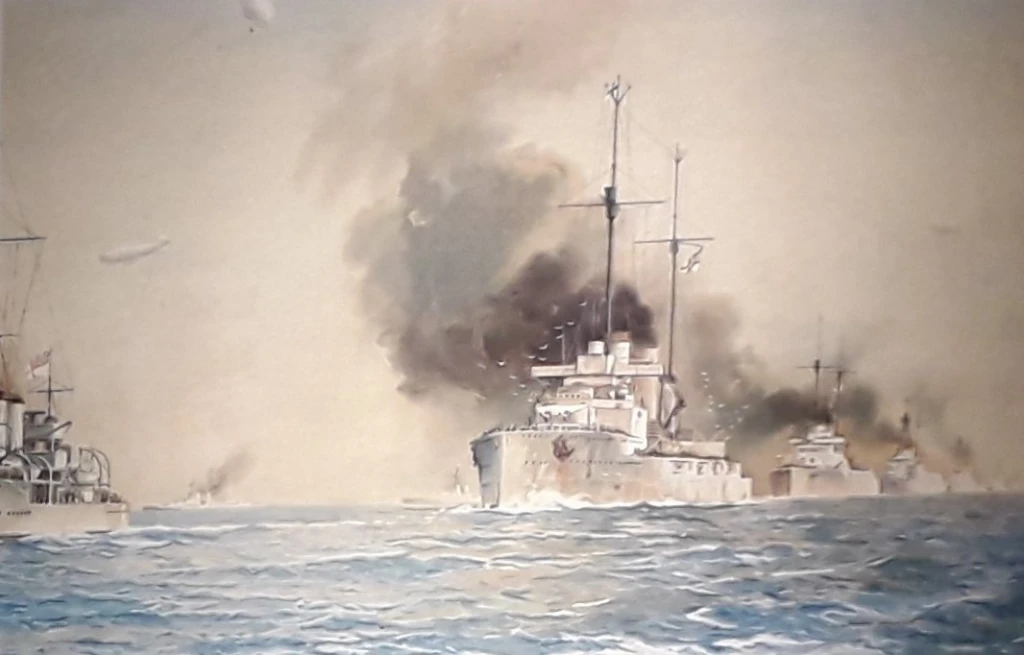
Norman Wilkinson PRI, ORI, RSA (1878-1971), Surrender of German High Seas Fleet, November 21st 1918, print after oil painting
Norman Wilkinson was born in Cambridge. He studied art in England and Paris, but was primarily interested in maritime subjects, working in oils, watercolours and drypoint. He was also an illustrator and poster artist for the Government and various railway companies.
He served with the Royal Naval Volunteer Reserve in World War I and, during this time, came up with the concept of dazzle camouflage for ships. His idea was adopted by the Admiralty, and Wilkinson was placed in charge of a naval camouflage unit, working with other artists on schemes
and models, which were tested and then applied to actual ships. Wilkinson also worked on camouflage of airfields in World War II, as well as travelling and recording the war at sea. The group of oil paintings he produced is now at the National Maritime Museum, Greenwich.
The print in the Scapa Flow Museum collection shows part of a larger oil painting depicting HMS Cardiff leading the German High Seas Fleet into the Firth of Forth on 21 November 1918, following which the 74 ships were interned in Scapa Flow. The original painting hangs in City Hall, Cardiff. See https://artuk.org/discover/artworks/hms-cardiff-158968/search/actor:wilkinson-norman-18781971/page/9
HMS Royal Oak, 1993
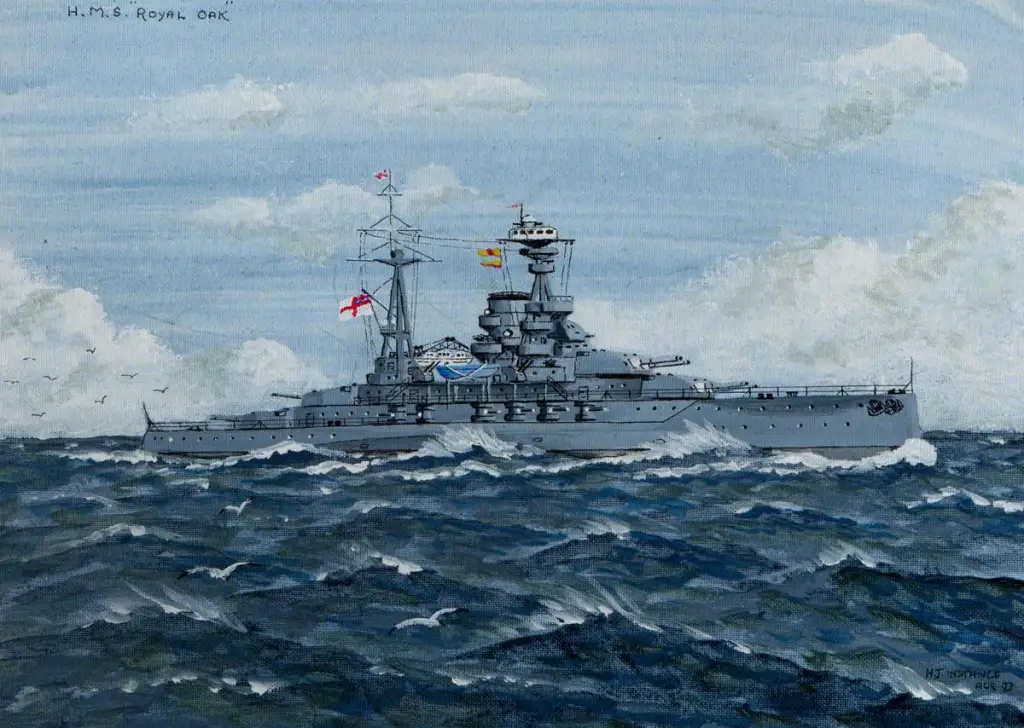
H.J. Instance, HMS Royal Oak, 1993, oil on canvas board
H.J. Instance, known as Joe, was a Leading Seaman on board HMS Royal Oak when she was torpedoed on 14 October 1939. He survived the sinking and rose to the rank of Lieutenant Commander during his naval career. He was also Secretary of the Royal Oak Association and his ashes were laid within the wreck by a Navy diver following his death in 2001.
He was a keen artist and painted several versions of this picture for fellow survivors, including Stanley Cole, whose widow, Nancy, presented it to the Scapa Flow Museum with other items belonging to her husband. See https://artuk.org/discover/artworks/hms-royal-oak-167512/search/keyword:h-j-instance
Search Lights (Air Raid in Scapa Flow), 1940
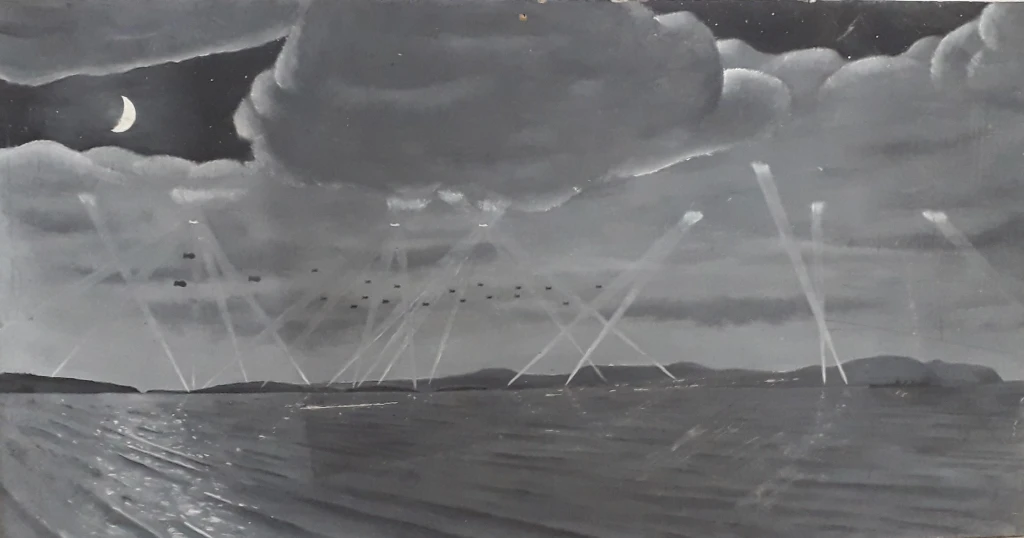
Sandy Wylie, Search Lights (Air Raid in Scapa Flow), 1940, oil on hardboard
The first air raid on Scapa Flow was in October 1939, the same month as the sinking of HMS Royal Oak. With Scapa Flow’s importance as a fleet anchorage and the naval base at Lyness, air and coastal defences were increased to protect the area from bombers and attack by sea. There was a network of anti-aircraft batteries, searchlight and radar stations on land, barrage balloons in the air, and induction loops, minefields, booms, nets and blockships in the water.
This view of an air raid in Scapa Flow from the south isles shows the searchlights and barrage balloons in action, picking out the enemy planes in white. It was painted by Sandy Wylie who is remembered as a former technician at Kirkwall Grammar School, an artist and inventor, and the first operator of rural cinema in Orkney from 1948.
HMS Orkney, 1990s
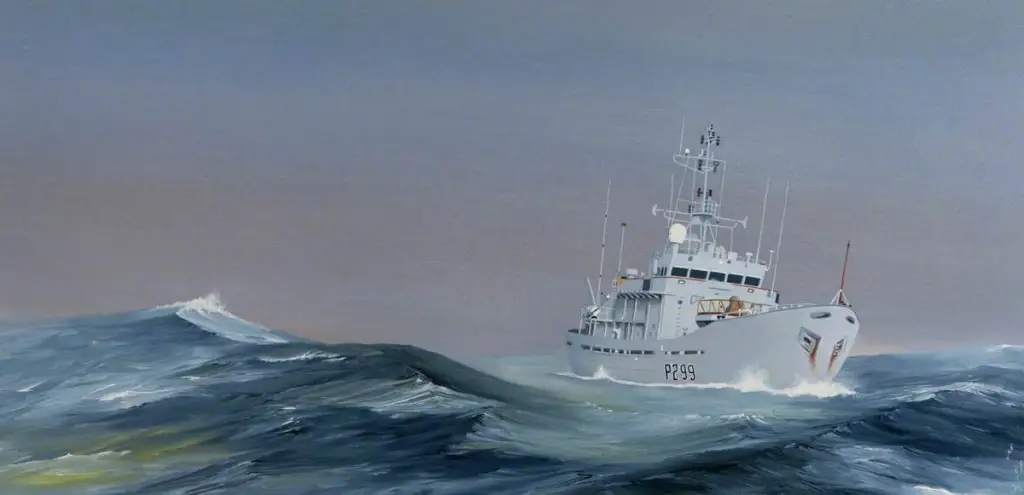
P.H., HMS Orkney, 1990s, oil on canvas
HMS Orkney (P299) was an island-class patrol vessel of the Royal Navy from 1977-1999. When she was sold to the Trinidad and Tobago Defence Force in 2000 and renamed TTS Nelson, various items from HMS Orkney were presented to Orkney Islands Council including her name plaque and ship’s badge. She was sold for scrap in 2016.
The artist of this painting, and another of MV Keila, is only known as P.H. See https://artuk.org/discover/artists/h-p-/view_as/grid/search/artists:h-p/page/1. Both paintings were donated by local collector, Roddy Hibbert.
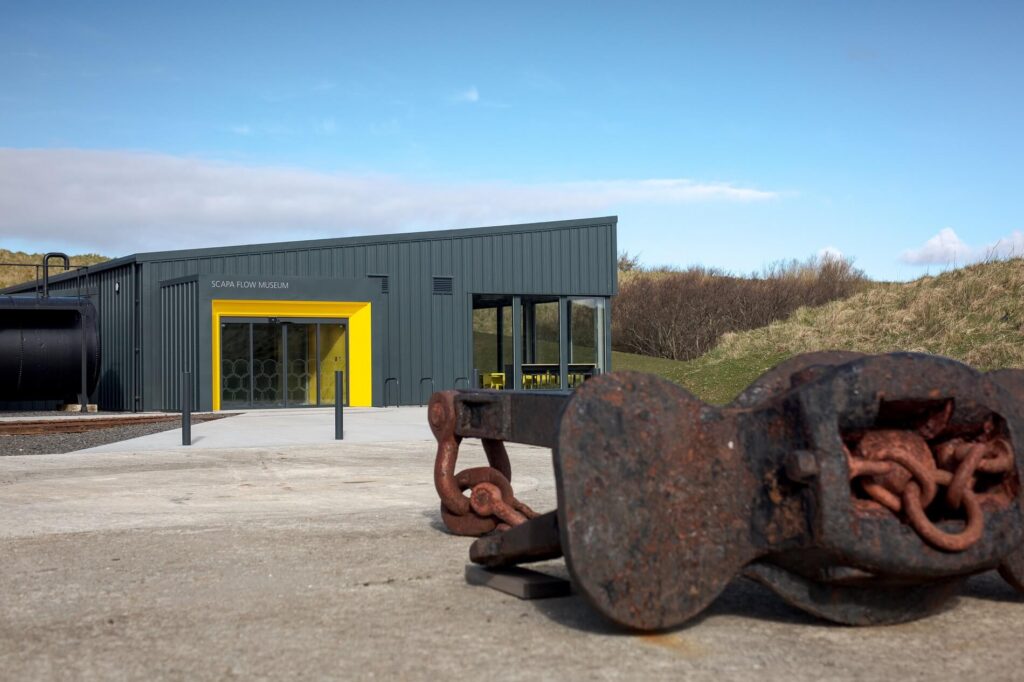
The Scapa Flow Museum at Lyness is undergoing a major refurbishment project, with funding from Orkney Islands Council, the National Lottery Heritage Fund, Historic Environment Scotland, the Orkney LEADER 2014-2020 programme, Highlands and Islands Enterprise, Museums Galleries Scotland and the Natural and Cultural Heritage Fund.
The project involves the restoration of historic buildings, enhancement of interpretation and displays, and the creation of a new building housing an exhibition space, café, toilet facilities and information areas. New display cases, lighting and environmental controls will allow us to display objects which have never been on show before, including some of the works of art in this blog.
